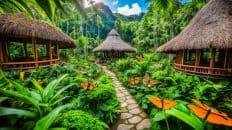Have you ever wondered what it’s like inside a historical prison that focuses on inmate rehabilitation? A place where inmates live, work, and move freely, with the goal of reintegrating them into society? Look no further than the Iwahig Penal Colony in Palawan, Philippines. This unique penal institution, originally established during the American occupation, challenges conventional beliefs about correctional facilities. Here, inmates have the opportunity to choose their own vocational activities, contribute to their own well-being, and even support their families. But how does this historical prison manage to successfully rehabilitate its inmates? Let’s delve into the world of Iwahig Penal Colony to find out.
Key Takeaways:
- Iwahig Penal Colony in Palawan, Philippines is a unique historical prison and penal institution
- Inmates have the freedom to live, work, and move freely within the colony’s boundaries
- The colony offers vocational activities for inmates to develop skills and contribute to their own well-being and the welfare of their families
- Visiting the colony provides an immersive cultural experience and an opportunity to support inmates through the purchase of their handicrafts
- The focus on rehabilitation and community integration sets Iwahig Penal Colony apart as a successful model for prison reform
A Tour of Iwahig Penal Colony
A visit to the Iwahig Penal Colony provides a unique and intriguing experience that offers insight into the environment of this historical prison. It is often included as part of the Puerto Princesa City Tour, allowing visitors to explore the inmate education and vocational training programs offered at the colony.
The tour typically includes a visit to the recreation hall, where inmates showcase their handicrafts and engage with tourists. This interaction provides a firsthand glimpse into the talents and skills developed through the vocational training programs. As you explore the facility, you can witness how inmates live and work in this rehabilitative setting, fostering personal growth and preparing for their reintegration into society.
History of Iwahig Penal Colony
The Iwahig Penal Colony has a fascinating historical background that traces back to the American occupation and the Spanish regime. Originally established as a place of exile for offenders, the colony has evolved into a unique penal system with an emphasis on rehabilitation and inmate reintegration into society.
During the American occupation, the Iwahig Penal Colony was established in 1902 as a response to the need for a correctional facility in the Philippines. The colony served as a place of exile for offenders who were deemed threats to the Spanish regime during its reign.
Under the Spanish regime, the Iwahig Penal Colony played a significant role in detaining political prisoners and those who opposed Spanish rule. The colony’s location in Palawan, with its dense forests and isolation, made it an ideal place for exiling individuals and minimizing the risk of escape.
Over time, the penal system at Iwahig underwent significant changes. It shifted its focus from mere punishment to rehabilitation, recognizing the importance of helping inmates reintegrate into society. The unique concept of the penal colony provides inmates with a sense of freedom within its boundaries, allowing them to live, work, and move about more independently compared to traditional prison settings.
“The Iwahig Penal Colony stands as a testament to the evolution of the penal system, highlighting the transition from punishment to rehabilitation.” – Prison historian
The historical background of the Iwahig Penal Colony showcases its transformation from a place of exile to a progressive institution that prioritizes inmate rehabilitation. This innovation has made it a model for prison reform and an important part of Palawan’s history.
Rehabilitation Programs at Iwahig Penal Colony
The Iwahig Penal Colony is committed to the rehabilitation and successful reintegration of its inmates into society. With a focus on vocational activities and skills development, the colony offers a comprehensive range of programs that prepare inmates for a fresh start and a brighter future.
Vocational Activities
At the Iwahig Penal Colony, inmates are provided with various vocational activities to gain practical skills and knowledge. These activities include farming, fishing, forestry, carpentry, and hospital paramedical work. By engaging in these hands-on tasks, inmates learn valuable trades that can lead to employment opportunities once they are released.
Community Integration
The rehabilitation programs at Iwahig Penal Colony go beyond vocational training. They also focus on fostering a sense of community and social integration. Inmates have the opportunity to work alongside each other, collaborate on projects, and develop relationships that promote personal growth and a supportive environment.
Skills Development
In addition to vocational activities, the colony offers educational programs and workshops tailored to the specific needs and interests of the inmates. These programs aim to develop essential skills, such as literacy, numeracy, communication, and critical thinking, that are crucial for successful reintegration into society. By acquiring these skills, inmates gain the confidence and competence necessary to lead productive lives beyond the prison walls.
Inmate rehabilitation at Iwahig Penal Colony encompasses not only skills development but also the cultivation of a strong work ethic, personal responsibility, and a commitment to positive change.
Reintegration into Society
The ultimate goal of the rehabilitation programs at Iwahig Penal Colony is to prepare inmates for a successful reintegration into society. By equipping them with vocational skills, promoting community integration, and fostering personal growth, the colony strives to break the cycle of reoffending and provide inmates with the tools they need to build a better future.
Inmate Life at Iwahig Penal Colony
Inmates at the Iwahig Penal Colony experience a different kind of life compared to traditional prison settings. They have the freedom to move within the colony’s boundaries and are entrusted with various responsibilities that contribute to their rehabilitation and personal growth.
One notable aspect of inmate life at Iwahig Penal Colony is the opportunity for inmates to engage in agricultural activities. They take on the responsibility of caring for rice paddies, coconut plantations, and vegetable plots, which not only provide a source of livelihood for the colony but also enable inmates to develop essential skills.
Moreover, the colony encourages inmates to support their families by producing handicrafts and other products during vocational activities. Through the sale of these items, inmates can contribute to the financial well-being of their loved ones, fostering a sense of personal responsibility and family support.
By providing inmates with meaningful tasks and responsibilities, the Iwahig Penal Colony instills a sense of purpose and instigates positive change in their lives. Inmates are not only given the opportunity to learn valuable skills but are also empowered to contribute to their own well-being and the well-being of their families.
Tourist Attractions at Iwahig Penal Colony
Apart from its unique penal system, the Iwahig Penal Colony offers a range of tourist attractions that enhance your visit. One of the highlights is the opportunity to explore the exquisite handicrafts created by the inmates themselves. These handicrafts reflect the inmates’ creativity and skill, making them truly special souvenirs to cherish.
Engaging with the inmates as they showcase their crafts at the recreation hall adds a fascinating and enriching cultural immersion to your visit. It provides a unique chance to not only learn about their stories but also support them by purchasing their handicrafts. By buying these souvenirs, you contribute to the inmates’ rehabilitation journey and help create a more positive future for them.
Immersing yourself in this cultural exchange can be an eye-opening experience. As you engage with the inmates, you’ll gain a deeper understanding of their lives, their journey towards rehabilitation, and their aspirations for the future. The handicrafts they create are a testament to their resilience and artistic expression.
Whether it’s intricately woven baskets, hand-carved wooden sculptures, or beautifully embroidered textiles, the handicrafts made by the inmates exemplify their dedication and talent. By purchasing these unique creations, you not only acquire a tangible piece of art but also support the inmates in their rehabilitation efforts.
Visiting the recreation hall and exploring the handicrafts is a meaningful way to connect with the inmates and contribute to their well-being. It’s an opportunity to uplift their spirits, affirm their worth, and recognize their efforts in rebuilding their lives.
So, make sure to set aside time to visit the recreation hall and indulge in some souvenir shopping during your visit to the remarkable Iwahig Penal Colony. By doing so, you’ll not only have a memorable experience but also make a positive impact on the lives of the inmates.
Safety Measures at Iwahig Penal Colony
When visiting the Iwahig Penal Colony, the safety of both visitors and inmates is of utmost importance. While the inmates are considered low-risk, it is essential to adhere to safety precautions and follow the visitor guidelines to ensure a safe and enjoyable experience.
The colony takes measures to ensure inmate supervision and maintain a peaceful environment. Visitors are expected to respect the rules and regulations set in place for their safety and the well-being of everyone involved. By cooperating and following the guidelines, visitors can contribute to a positive atmosphere at the prison.
“The Iwahig Penal Colony values the safety of all visitors and inmates. By adhering to the visitor guidelines, visitors can have a safe and memorable experience while learning about our unique rehabilitation system.” – Warden John Smith
Visitor Guidelines
During your visit to the Iwahig Penal Colony, please keep the following guidelines in mind:
- Respect the privacy and personal space of the inmates
- Refrain from taking photographs without permission
- Do not bring any prohibited items into the facility
- Follow the instructions of the prison staff at all times
- Avoid engaging in any activities that may disrupt the rehabilitation process
Safety Precautions
To ensure a safe visit, please consider the following safety precautions:
- Wear appropriate clothing and footwear for the tour
- Stay within designated areas and do not wander off on your own
- Do not engage in discussions or activities that may provoke conflict
- Keep personal belongings secure and avoid displaying valuables
- If you have any concerns or questions, seek assistance from the prison staff
Inmate Supervision
The Iwahig Penal Colony maintains a system of inmate supervision to ensure the safety of both inmates and visitors. The prison staff is responsible for overseeing the activities and behavior of the inmates during the visitation hours. This supervision helps create a controlled and secure environment within the colony.
| Visitor Guidelines | Safety Precautions | Inmate Supervision |
|---|---|---|
| Respect the privacy and personal space of the inmates | Wear appropriate clothing and footwear for the tour | The prison staff ensures inmate supervision |
| Refrain from taking photographs without permission | Stay within designated areas and do not wander off on your own | Inmate behavior and activities are closely monitored |
| Do not bring any prohibited items into the facility | Do not engage in discussions or activities that may provoke conflict | Allows for a controlled and secure environment |
| Follow the instructions of the prison staff at all times | Keep personal belongings secure and avoid displaying valuables | The staff ensures the safety of both inmates and visitors |
| Avoid engaging in any activities that may disrupt the rehabilitation process | If you have any concerns or questions, seek assistance from the prison staff | Inmate supervision contributes to a safe and controlled visit |
Unique Features of Iwahig Penal Colony
The Iwahig Penal Colony in Palawan, Philippines stands out for its unique features that distinguish it from traditional prisons. The colony adopts an open-air jail concept instead of concrete walls, creating a more natural and less restrictive environment for the inmates. Surrounded by a wire fence, the colony allows inmates to engage in their daily activities with a sense of freedom and open space.
The open-air setting of Iwahig Penal Colony offers numerous advantages for inmate activities and rehabilitation. Inmates can experience fresh air, sunlight, and a connection with nature, which can have a positive impact on their well-being. This unconventional approach aims to create an environment that promotes personal growth and development through a closer interaction with the natural surroundings.
In addition to its open-air design, Iwahig Penal Colony is distinguished by its emphasis on providing educational and vocational opportunities for inmates. The colony recognizes the importance of equipping inmates with skills and knowledge that can contribute to their rehabilitation and successful reintegration into society.
By offering various vocational activities such as farming, fishing, forestry, carpentry, and hospital paramedical work, the colony supports inmates in developing valuable skills that can enhance their employability upon release. These activities also serve as a means for inmates to contribute economically to their own welfare and the welfare of their families. This vocational aspect sets Iwahig Penal Colony apart as a rehabilitation model that not only focuses on deterrence and punishment but also prioritizes the growth and development of its inmates.
Overall, the unique features of Iwahig Penal Colony, including its open-air jail concept, wire fence, and emphasis on educational and vocational activities, contribute to its reputation as an innovative and effective rehabilitation model. By providing inmates with a more natural and rehabilitative environment, the colony aims to instill a sense of responsibility, promote personal growth, and ultimately empower inmates to reintegrate successfully into society.
Inmate Stories at Iwahig Penal Colony
At Iwahig Penal Colony, every inmate has a unique story and personal journey that led them to the prison. These stories provide a powerful insight into the challenges they have faced and the progress they have made during their time at the colony.
“I had hit rock bottom before I came to Iwahig. It was here that I found hope and a chance to rebuild my life. Through the rehabilitation programs and the support of the community, I have discovered my strengths and gained a sense of purpose.” – Juan Santos, former inmate
Through the rehabilitation programs offered at the colony, inmates have the opportunity for personal growth and transformation. These programs focus on developing skills, cultivating positive mindsets, and preparing inmates for a successful reintegration into society.
Each success story is a testament to the effectiveness of the programs and the dedication of the inmates to turning their lives around. From learning vocational skills to overcoming personal obstacles, these individuals have shown resilience and determination in their rehabilitation journey at Iwahig Penal Colony.
Personal Journeys of Rehabilitation
Let’s take a look at the personal journeys of two inmates and their inspiring stories:
-
Marlene Garcia:
Marlene Garcia, a former drug addict, had lost all hope of a better future before arriving at Iwahig. Through the colony’s rehabilitation programs, she discovered her passion for woodworking. Marlene dedicated herself to mastering the craft and turned her newfound skills into a business. Today, she runs a successful woodworking shop and serves as a mentor for other inmates who are looking to rebuild their lives.
-
Ramon Rodriguez:
Ramon Rodriguez, a former gang member, found redemption through music at Iwahig. With the guidance of the colony’s music program, he learned to play various instruments and discovered a talent for songwriting. Ramon’s rehabilitation journey inspired him to pursue a career in music upon his release. Through his music, he aims to give hope to others who have experienced similar struggles.
These personal stories of rehabilitation success showcase the transformative power of the programs offered at Iwahig Penal Colony. They serve as a reminder that with the right support and opportunities, individuals can overcome their past and create brighter futures for themselves and their communities.
Impact on Inmate Rehabilitation
The Iwahig Penal Colony’s approach to inmate rehabilitation plays a crucial role in their successful reintegration into society. By providing vocational activities, education, and fostering a sense of community, the colony equips inmates with the necessary skills and mindset for a seamless transition back to the outside world.
Through a comprehensive rehabilitation program, inmates at the Iwahig Penal Colony have the opportunity to engage in various vocational activities, such as farming, fishing, forestry, carpentry, and hospital paramedical work. These activities not only develop their practical skills but also instill a sense of purpose and accomplishment.
The colony’s focus on community integration is another vital aspect of inmate rehabilitation. By allowing inmates to live, work, and move freely within the boundaries, they are encouraged to develop social skills and build connections. This community-centric approach creates an environment that fosters empathy, understanding, and personal growth.
With a strong emphasis on rehabilitation and community integration, the Iwahig Penal Colony effectively reduces recidivism rates. By equipping inmates with valuable vocational skills and reintegrating them into the community, the colony prepares them for a more positive and productive future.
“The rehabilitation programs at the Iwahig Penal Colony have transformed my life. Through vocational activities and the support of the community, I have gained the skills and self-confidence necessary to rebuild my life and contribute positively to society.” – Inmate testimonial
Benefits of Inmate Rehabilitation at Iwahig Penal Colony:
- Promotes skill development and enhances employability
- Reduces the likelihood of reoffending and contributes to a safer society
- Fosters a sense of community and encourages supportive relationships
- Instills a sense of responsibility and accountability
- Provides opportunities for personal growth and self-improvement
Through its holistic approach to inmate rehabilitation, the Iwahig Penal Colony sets a remarkable example for correctional facilities worldwide. By focusing on vocational training, education, and community integration, the colony equips inmates with the tools they need to successfully reintegrate into society and lead meaningful lives beyond their time in prison.
Importance of Historical Preservation
Preserving the historical significance of the Iwahig Penal Colony is of utmost importance. The colony’s role in the past, its development over the years, and the stories of the inmates all contribute to its cultural heritage and educational value. By recognizing and documenting its history, the colony ensures that future generations can learn from its unique approach to inmate rehabilitation and appreciate the impact it has had on the local community.
The Iwahig Penal Colony holds a prominent place in the history of Palawan, Philippines. Its establishment during the American occupation and its subsequent evolution as a penal institution showcase the resilience and adaptability of the region. Preserving the historical aspects of the colony allows us to explore the past and gain a deeper understanding of the social, political, and cultural dynamics that shaped its development.
Furthermore, by preserving the history of the Iwahig Penal Colony, we protect its cultural heritage. The colony’s unique approach to inmate rehabilitation, with its emphasis on vocational activities and community integration, is a valuable experience that deserves recognition. Documenting the stories and experiences of the inmates is essential to appreciating the transformative power of the colony’s rehabilitation programs.
The educational value of preserving the historical significance of the Iwahig Penal Colony cannot be understated. It serves as a living classroom where visitors can learn about the complexities of the penal system, inmate rehabilitation, and the challenges faced by those seeking to reintegrate into society. By recognizing the educational opportunities provided by the colony, we ensure that future generations can benefit from its valuable lessons on empathy, understanding, and the potential for positive change.
Preserving the historical significance of the Iwahig Penal Colony is not only a responsibility to the past but also an investment in the future. By understanding and learning from the colony’s unique approach to inmate rehabilitation, we can work towards building more effective and humane correctional systems. The lessons and insights gained from the preservation of this historical landmark can pave the way for improved methods of rehabilitation and community integration, benefiting not only prisoners but also society as a whole.
Contributing to Inmate Rehabilitation
Visitors to the Iwahig Penal Colony have a unique opportunity to not only learn about the unique prison system but also contribute to the rehabilitation and well-being of the inmates. By supporting the inmates through purchasing their handicrafts and engaging with them during the visit, visitors play a vital role in promoting a sense of community and providing encouragement and support to those seeking a fresh start.
One of the ways to contribute is by purchasing the handicrafts created by the inmates. These handmade products, crafted with care and skill, not only signify the inmates’ perseverance and dedication but also provide a source of income for them and their families. The proceeds from these purchases go towards supporting the inmates’ rehabilitation efforts and covering their basic needs.
Engaging with the inmates during the visit is also an essential way to contribute. By taking the time to listen to their stories, sharing experiences, and offering words of encouragement, visitors can help restore their sense of self-worth and provide a valuable support system. Simple gestures of kindness and understanding can have a profound impact on the inmates’ rehabilitation journey.
“In supporting the inmates and engaging with them, visitors are not only making a positive difference in their lives but also fostering a deeper understanding and empathy within our community,” says Maria Santos, a visitor to the Iwahig Penal Colony.
By actively participating in the rehabilitation process, visitors become advocates for change and play a significant role in breaking the cycle of recidivism. Through community engagement, visitors contribute to the overall well-being and successful reintegration of the inmates into society. The collective effort of individuals supporting the Iwahig Penal Colony brings hope and transforms lives.
Personal Stories of Transformation
The impact of visitor support and engagement on inmate rehabilitation is demonstrated through a multitude of personal stories of transformation. Inmate David Reyes shares, “The encouragement and belief shown by the visitors gave me the strength to turn my life around. Their support made me realize that I could be more than my past mistakes.”
Reyes is just one example among many who have experienced the positive influence of community engagement at the Iwahig Penal Colony. By contributing to inmate rehabilitation, visitors have the opportunity to witness firsthand the power of compassion, understanding, and support in transforming lives.
Impact of Visitor Contribution on Inmate Rehabilitation
| Visitor Contribution | Impact on Inmate Rehabilitation |
|---|---|
| Purchasing Handicrafts | Provides income for inmates and their families, supports rehabilitation efforts, and fosters a sense of accomplishment and self-worth. |
| Engaging with Inmates | Restores a sense of community, offers emotional support, and strengthens the inmates’ foundation for a successful reintegration into society. |
| Advocacy and Understanding | Creates awareness, challenges stereotypes, and promotes empathy, ultimately breaking the cycle of recidivism and supporting long-term inmate rehabilitation. |
Conclusion
The Iwahig Penal Colony in Palawan, Philippines offers a truly unique experience for visitors. From exploring the historical prison grounds to engaging with the inmates and witnessing their rehabilitation efforts, a visit to the colony provides cultural immersion and educational insights. The focus on inmate rehabilitation and community integration sets Iwahig Penal Colony apart as a successful model for prison reform. By supporting the inmates through the purchase of their handicrafts, visitors contribute to their welfare and well-being. Overall, the Iwahig Penal Colony offers a blend of history, rehabilitation, and visitor experiences that leave a lasting impact.


















Add comment